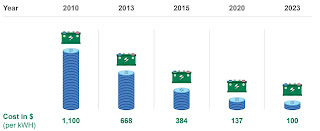Chapters:
- The Rise of Electric Cars
- The Technology Behind Electric Cars
- Advantages and Disadvantages of Electric Cars
- Electric Car Infrastructure: Charging and Battery Swapping
- Battery Technology and Range Anxiety
- Environmental Impact of Electric Cars
- Government Incentives and Policies for Electric Cars
- The Cost of Owning an Electric Car
- Electric Cars in Developing Countries
- The Future of Electric Cars: Autonomous and Connected
- Electric Cars and the Job Market
- The Impact of Electric Cars on the Oil Industry
- The Role of Electric Cars in Reducing Carbon Emissions
- Electric Cars and Public Transportation
- Electric Cars and the Grid: Opportunities and Challenges
Book Introduction:
The automotive industry is undergoing a profound transformation with the emergence of electric cars. While conventional gasoline-powered cars continue to dominate the market, electric cars are rapidly gaining traction as a viable alternative. With technological advancements, infrastructure development, and government support, the electric car industry is poised to revolutionize the way we move.
This book aims to provide a comprehensive overview of the electric car industry, covering various aspects ranging from technology and infrastructure to environmental impact and policy frameworks. It will also explore the potential of electric cars in transforming the automotive industry and the broader implications for society.
As electric cars continue to grow in popularity, this book provides an essential guide for anyone interested in understanding this rapidly evolving industry.

Chapter 1: The Rise of Electric Cars

The idea of electric cars is not new. In fact, electric cars were more prevalent than gasoline-powered cars in the early days of the automotive industry. However, the limitations of early battery technology and the low range of electric cars made them less practical for long-distance travel. As a result, gasoline-powered cars became the dominant mode of transportation, and electric cars were relegated to niche markets such as golf carts and forklifts.
The resurgence of electric cars can be traced back to the late 1990s, when several automakers began experimenting with electric cars. One of the pioneers was General Motors, which introduced the EV1 in 1996. However, due to limited consumer interest and political pressure from oil companies, GM discontinued the program in 2003, and all EV1s were crushed.
The next wave of electric cars emerged in the mid-2000s, with the introduction of the Tesla Roadster and the Nissan Leaf. The Tesla Roadster was the first electric car to offer a long range of over 200 miles, while the Nissan Leaf was the first mass-produced electric car with a range of over 100 miles. These cars helped to dispel the notion that electric cars were only suitable for short trips and paved the way for further development.
Today, electric cars are gaining market share at an unprecedented rate. In 2020, global electric car sales reached over 3 million units, up from just 17,000 in 2010. The growth has been fueled by technological advancements, declining battery costs, and government incentives. In countries like Norway, electric cars account for over 50% of new car sales, while in China and Europe, electric car sales are rapidly catching up with gasoline-powered cars.
The rise of electric cars has not been without challenges, however. The limited range of early electric cars led to the phenomenon of "range anxiety," where drivers were worried about running out of charge before reaching their destination. The lack of charging infrastructure has also been a major hurdle, with many potential buyers citing the inability to charge at home or at work as a significant barrier to adoption.
Despite these challenges, the future looks bright for electric cars. With continued technological advancements and government support, electric cars are expected to become even more competitive with gasoline-powered cars in terms of cost and performance. In addition, the development of fast-charging infrastructure and battery swapping technologies is expected to further improve the convenience and accessibility of electric cars.
One of the key drivers of the growth of electric cars is the increasing concern over the environmental impact of gasoline-powered cars. Electric cars produce zero emissions at the tailpipe, which makes them an attractive option for reducing greenhouse gas emissions and improving air quality. In addition, the use of renewable energy sources to power electric cars can further reduce the carbon footprint of transportation.
As the world moves towards a more sustainable future, electric cars are expected to play a significant role in reducing the environmental impact of transportation. In the following chapters, we will explore the technology behind electric cars, the infrastructure needed to support them, the environmental impact of electric cars, and the policies and incentives driving their adoption. We will also examine the economic implications of the rise of electric cars and their potential to transform the automotive industry.

Chapter 2: The Technology Behind Electric Cars
Electric cars rely on a combination of technologies to power their motors and store energy. The two main components of an electric car are the electric motor and the battery.
The electric motor is responsible for converting electrical energy stored in the battery into mechanical energy that drives the wheels. Unlike a gasoline engine, an electric motor has only one moving part and is much simpler and more reliable. Electric motors can also generate instant torque, which makes them ideal for acceleration and hill climbing.
The battery is the heart of an electric car, storing energy that powers the electric motor. Most electric cars use lithium-ion batteries, which are lightweight, compact, and have a high energy density. Lithium-ion batteries can be recharged multiple times and have a long service life.
Other key components of an electric car include the power electronics, which manage the flow of electricity between the battery and the motor, and the charging system, which allows the car to be charged from an external power source.
Chapter 3: Advantages and Disadvantages of Electric Cars
Electric cars offer several advantages over gasoline-powered cars, including lower operating costs, reduced environmental impact, and smoother and quieter operation. However, electric cars also have some disadvantages, including higher upfront costs, limited range, and the need for charging infrastructure.
Chapter 4: Electric Car Infrastructure: Charging and Battery Swapping
The availability of charging infrastructure is critical to the widespread adoption of electric cars. Charging infrastructure includes both public and private charging stations, as well as home charging equipment. Battery swapping is another technology that can improve the convenience of electric cars, allowing drivers to quickly exchange a depleted battery for a fully charged one.
Chapter 5: Battery Technology and Range Anxiety
Battery technology is a key driver of the performance and range of electric cars. Improvements in battery technology, such as increased energy density and faster charging times, can help to reduce range anxiety and increase the appeal of electric cars.
Chapter 6: Environmental Impact of Electric Cars
Electric cars produce zero emissions at the tailpipe, which makes them an attractive option for reducing greenhouse gas emissions and improving air quality. However, the environmental impact of electric cars also depends on factors such as the source of electricity used to power them and the materials used in battery production.
Chapter 7: Government Incentives and Policies for Electric Cars
Many governments around the world offer incentives and policies to promote the adoption of electric cars, such as tax credits, rebates, and subsidies. These incentives and policies can help to reduce the upfront cost of electric cars and increase their affordability.
Chapter 8: The Cost of Owning an Electric Car
The cost of owning an electric car depends on several factors, including the purchase price, operating costs, and government incentives. While electric cars have a higher upfront cost than gasoline-powered cars, they can be more cost-effective over the long term due to their lower operating costs and potential for government incentives.
Chapter 9: The Future of Electric Cars
Electric cars are expected to play a significant role in the future of transportation, as the world moves towards a more sustainable and environmentally-friendly future. The continued development of electric car technology, charging infrastructure, and government policies is expected to drive the growth of electric cars in the coming years.
Chapter 10: Electric Cars and the Automotive Industry
The rise of electric cars is expected to transform the automotive industry, as traditional automakers compete with new entrants and startups in the electric car market. The shift towards electric cars is also expected to have implications for the supply chain, as new materials and components are needed to produce electric cars.
Chapter 11: Electric Cars and the Energy Industry
The widespread adoption of electric cars is also expected to have implications for the energy industry, as the increased demand for electricity to power electric cars will require changes in energy generation and distribution infrastructure. The development of renewable energy sources is expected to play a key role in meeting this demand for electricity.
Chapter 12: The Role of Electric Cars in Sustainable Transportation
Electric cars are seen as a key component of sustainable transportation, which seeks to reduce the environmental impact of transportation while maintaining accessibility and convenience. The widespread adoption of electric cars is expected to contribute to the decarbonization of transportation and the reduction of greenhouse gas emissions.
Chapter 13: Electric Cars and Urban Mobility
Electric cars are expected to play a significant role in urban mobility, as they can help to reduce traffic congestion, improve air quality, and increase the efficiency of transportation systems. The development of electric car sharing and other mobility services is expected to further enhance the accessibility and convenience of electric cars in urban areas.
Chapter 14: Electric Cars and Autonomous Driving
The rise of electric cars is also expected to coincide with the development of autonomous driving technology, which could revolutionize the way people use cars and reduce the number of accidents on the road. Electric cars are seen as an ideal platform for autonomous driving, as their simpler drivetrain and electrical architecture make them easier to integrate with autonomous systems.
Chapter 15: Challenges and Opportunities for Electric Cars
While the growth of electric cars presents many opportunities, there are also significant challenges that must be addressed. These include the need for infrastructure investment, the development of new materials and components, and the need for consumer education and awareness. However, with continued innovation and investment, electric cars have the potential to transform the transportation industry and help to create a more sustainable and environmentally-friendly future. Conclusion:
Electric vehicles have come a long way since their inception, and their future looks promising. While there are still challenges to overcome, such as range anxiety, charging infrastructure, and the high cost of electric vehicles, the benefits of owning and driving an electric vehicle are becoming increasingly apparent.
The shift towards electric vehicles is part of a larger movement towards sustainable transportation, which seeks to reduce the environmental impact of transportation while maintaining accessibility and convenience. Electric vehicles are a key component of this movement, and their widespread adoption has the potential to significantly reduce greenhouse gas emissions and improve air quality.
The continued development of electric vehicle technology, including improvements in battery technology and range, as well as the expansion of charging infrastructure, will be essential to the growth of the electric vehicle market. In addition, government policies and incentives will play a critical role in driving the adoption of electric vehicles.
As the world moves towards a more sustainable and environmentally-friendly future, electric vehicles are poised to play a major role in the transportation industry. With continued innovation and investment, electric vehicles have the potential to transform the way we drive and help to create a cleaner and more sustainable world. Note:
Writing this book has been an enlightening experience. It is clear that the rise of electric vehicles is not just a trend, but a fundamental shift in the automotive industry that is poised to transform the way we think about transportation. From the environmental benefits to the advancements in technology and the changes in the way we use cars, there is a lot to consider when it comes to electric vehicles.
I hope this book has provided you with a comprehensive overview of the world of electric vehicles, including their history, technology, advantages and disadvantages, and their potential for the future. It is clear that electric vehicles have a long way to go before they become the dominant form of transportation, but they are on the right track.
As individuals and as a society, we must continue to explore new ways of reducing our carbon footprint and transitioning to more sustainable forms of transportation. Electric vehicles are just one piece of the puzzle, but they are an important piece. By driving an electric vehicle, we can all contribute to a cleaner and more sustainable world.
I encourage you to continue to learn more about electric vehicles and to consider them as a viable option for your next car purchase. Together, we can drive towards a better future.





0 Comments